How To Check For Viruses On An iPhone

Updated:
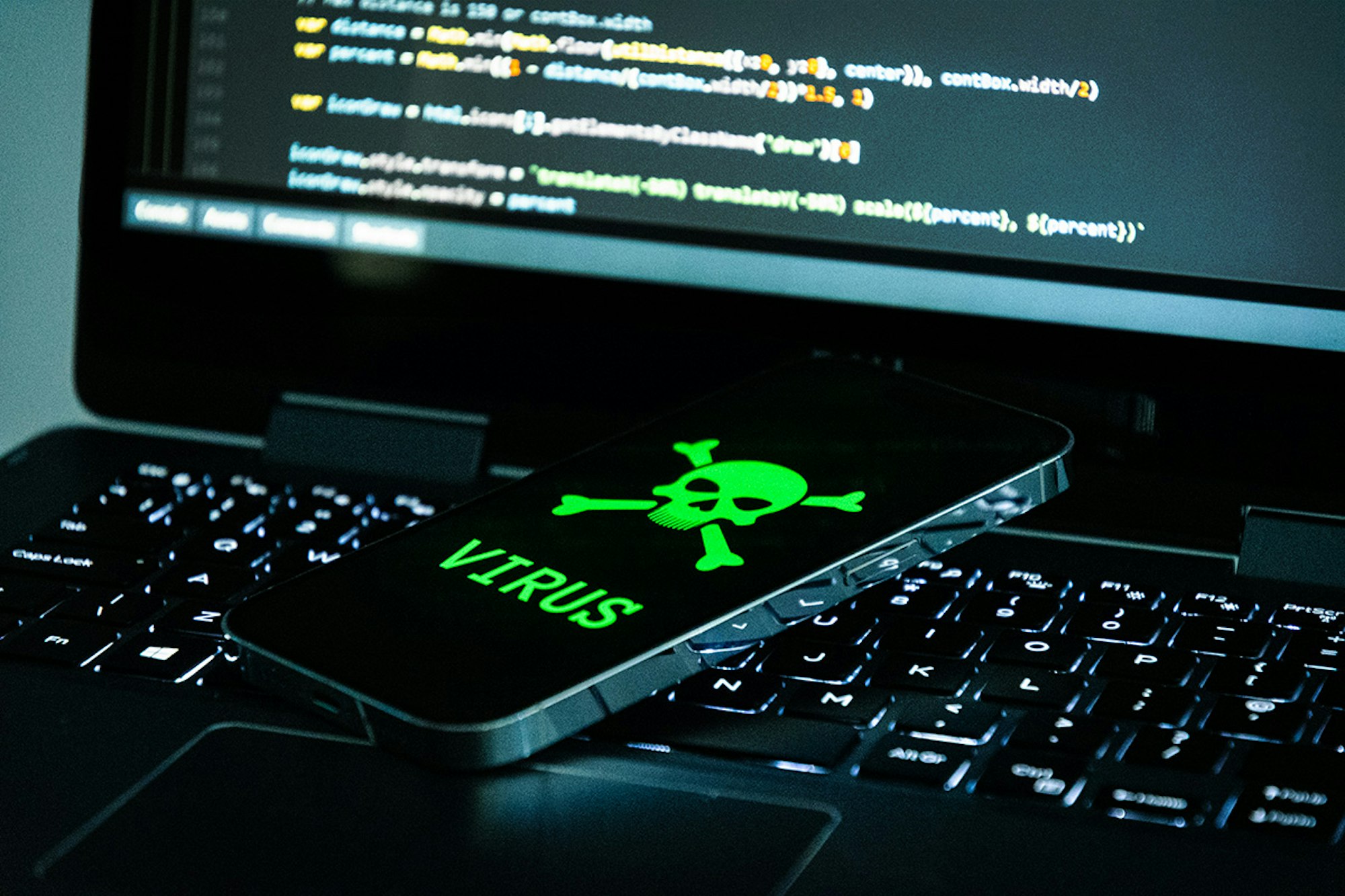
Your iPhone isn’t just a mobile device, it’s an extension of you, containing everything from your photos to sensitive emails.
Compared to Android devices—which are 50 times more likely to be infected with malware—iPhone’s are generally considered safer thanks to Apple’s closed ecosystem and rigorous App Store review process.
But like any connected technology, the iPhone is not immune to threats and can get viruses occasionally. In September 2023, Canadian researchers unveiled a startling discovery. They found a ‘zero-click’ spyware capable of infiltrating an iPhone by sending malicious images through iMessage.
This type of iPhone malware requires no user interaction to infect devices. Let that sink in.
So, maybe an iOS device isn’t as safe as you think. Protecting your devices from threats is crucial. The best defense is vigilance and recognizing signs of a malware attack.
In this article, we’ll guide you through the steps to check your iPhone for viruses or malware.
Let’s get started on ensuring your iPhone is secure.
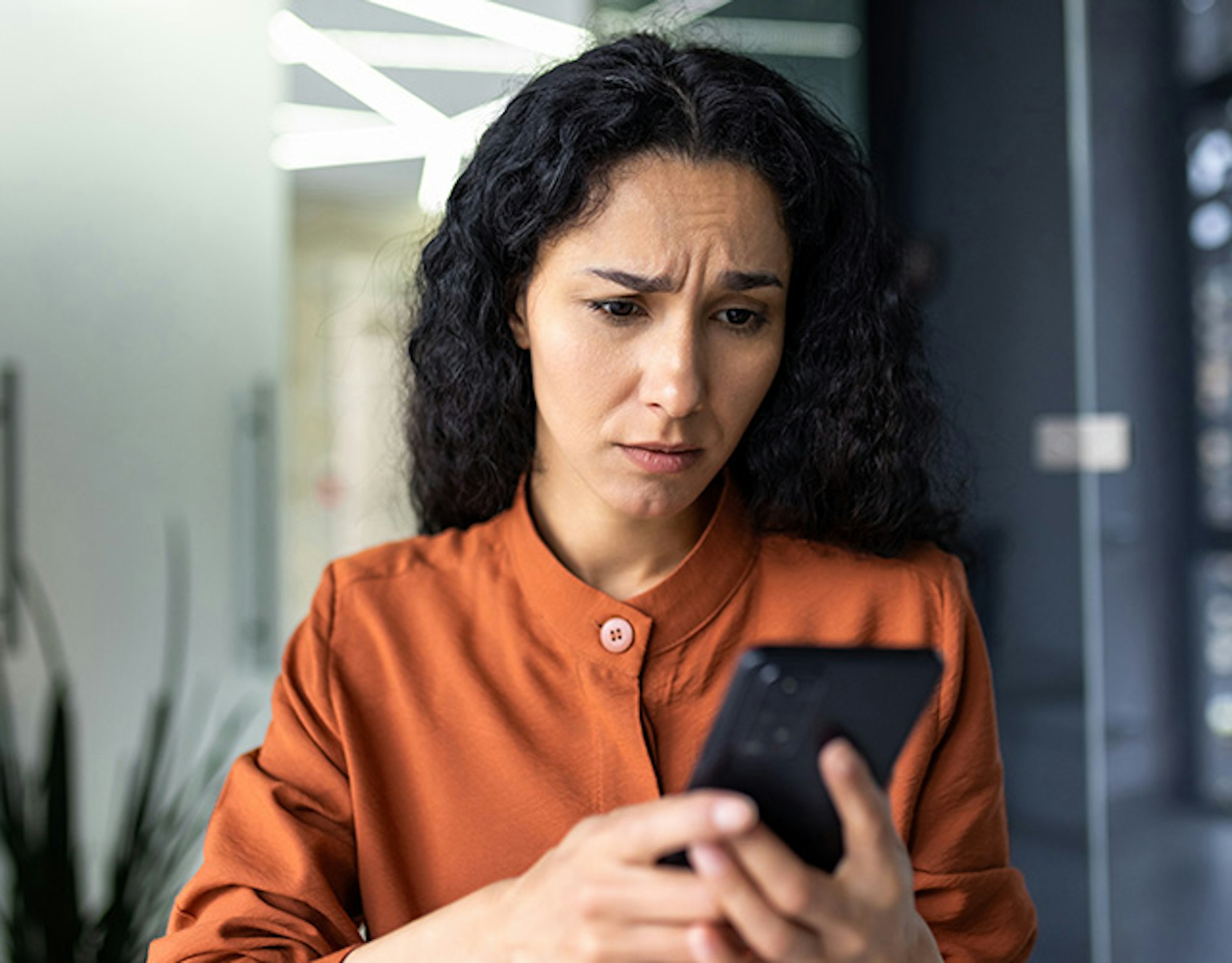
Think Your iPhone Has A Virus?
Quickly and easily check your iPhone for viruses and other threats today, with the award-winning Certo AntiSpy.
How to Check for Viruses on iPhone
1. Look out for unusual phone behavior
Here are some common indicators that your iPhone may be compromised with viruses and malware:
🚫 Unexpected pop-ups or ads
An increasing number of pop-up ads on your mobile device could be a red flag. While some websites naturally trigger pop-ups, seeing them appear randomly when not browsing the web is unusual and may indicate adware or malware attacks.
Also, watch for spam messages and unsolicited calendar invites.
📈 Unexplained increase in data usage
A malware infection can use your data to communicate back to a malicious server, leading to an unexplained surge in data usage.
If you notice your monthly data consumption spiking without any changes in your usage habits, it’s worth investigating.
💥 Apps crash frequently without explanation
While occasional app crashes aren’t uncommon, a sudden increase in frequency might be cause for concern.
Malware or security breaches can cause instability in otherwise reliable apps, leading to frequent crashes.
🔋 Battery draining more quickly than usual
Malicious software running in the background can consume more power, causing your iPhone battery to drain faster than normal.
If your iPhone’s battery life suddenly decreases, despite similar usage patterns, malware may be the culprit.
📱 Unfamiliar apps appearing on your home screen
If you notice new apps on your iPhone that you don’t recall downloading, it could be a sign of a security issue.
Some malware types can install additional software on your device without your consent.
💡 Don't Panic!
If you encounter one or more of these symptoms, don't fret. Not all of these issues are caused by malware; sometimes, they can be due to software bugs or other technical problems.
However, taking these signs seriously and investigating further can help protect your iPhone from potential harm.
Run a virus scan if you want to find out for sure.
2. Check if the ‘Cydia’ or ‘Sileo’ app is installed on your device
The presence of apps like ‘Cydia’ or ‘Sileo’ on your iPhone can be a telltale sign of jailbreaking, a common prerequisite for many iPhone viruses.
Jailbroken iPhones allow users to bypass Apple’s restrictions, potentially exposing the device to security vulnerabilities.
It’s important to note that for Apple devices that have been jailbroken, the icons for these apps can be hidden from the home screen, making them challenging to spot with a casual glance.
To thoroughly check whether ‘Cydia’ or ‘Sileo’ are installed, follow these steps:
- Start on your home screen: Begin by carefully examining your iPhone’s home screen and any app folders for apps named ‘Cydia’ and ‘Sileo’.
- Use the search function: Tap anywhere on the home screen not occupied by app icons and swipe down to reveal the search box. This feature allows you to search your entire device.
- Conduct a search: Enter each of the following terms into the search box: ‘Cydia’, ‘Sileo,’ ‘checkra1n’, ‘unc0ver’, and ‘SBSettings’.
If any of these show up in the search results, then your device is likely jailbroken.

Fig 1: Searching for Jailbreak apps on iPhone.
💡 Related: Is Jailbreaking Still Possible in 2024?
3. Check if your iPhone has a custom keyboard installed
Malicious custom keyboards installed on your iPhone can act as keyloggers which can be used to steal any data that you type into your phone, such as your usernames and passwords.
To check for and delete unrecognized custom keyboards on your iPhone, follow these steps:
- Go to iPhone Settings > General > Keyboard.
- Tap Keyboards.
- Tap Edit.
- Tap the red minus button next to any keyboard you don’t recognize.
- Tap Delete.
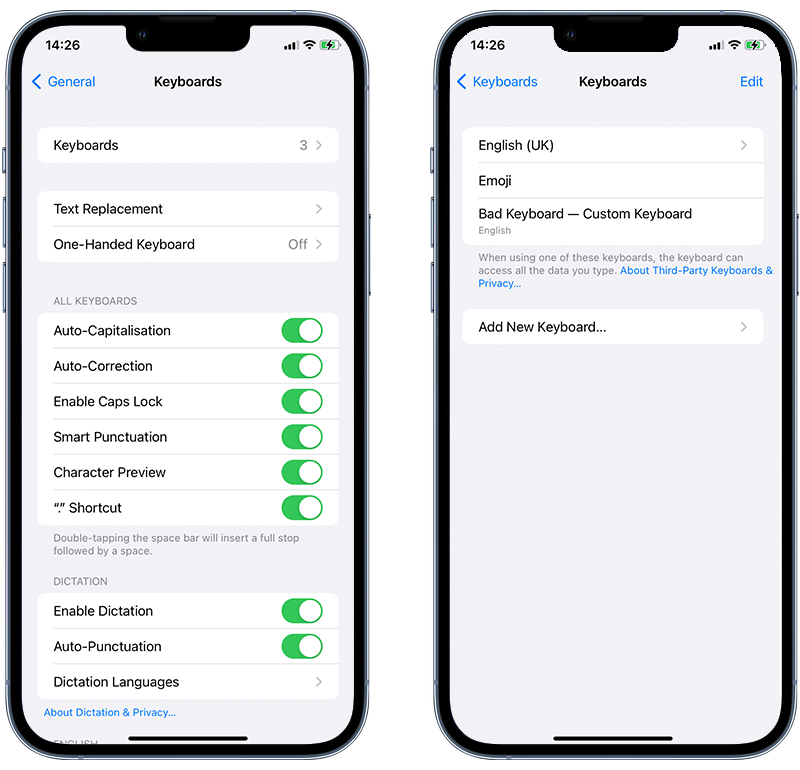
Fig 2. Checking for a custom keyboard on iPhone.
💡 Note: By default, most devices have two keyboards: Your chosen language (e.g. English (US) and Emoji).
4. Are there any unknown Enterprise/Developer apps installed?
Developer apps
Developer Mode on an iPhone is a setting that allows developers to run and test apps they are developing directly on the iPhone.
When Developer Mode is enabled, the device can install and launch apps that are not distributed through the official App Store.
This is particularly useful for developers who need to test their apps on actual devices to ensure they function correctly before submitting them to the App Store for review.
However, if a hacker creates a malicious app in advance, all they need to do is get hold of the victim’s phone for a short period and load it onto the phone from their computer.
Typically, they will hide the app in an app folder like ‘Utilities’, so it will go unnoticed for as long as possible.
💡 Key Point: For the average user, the benefits of Developer Mode might not outweigh the risks. If you're not using your device for development tasks or other specialized functions, it's recommended to keep this mode disabled.
To switch Developer Mode off on an iPhone, you can follow these steps:
- Start by opening the Settings app on your iPhone.
- Scroll down, tap Privacy & Security and look for the Developer Mode option.
- Tap on the Developer Mode option, and then switch off the toggle for Developer Mode. You might need to confirm your choice to disable Developer Mode.
- After disabling Developer Mode, your iPhone will likely prompt you to restart the device to apply the changes. Proceed with the restart.

Fig 3. Checking for Developer Mode on iPhone.
⚠️ Note: If you do not see the Developer Mode option, then Developer Mode has never been active on your device.
Delete unrecognized profiles
Like developer mode, Apple has allowed organizations to create and use Enterprise apps to distribute apps internally among their teams without making them publicly available on the App Store.
However, hackers have turned this feature into a way to trick users into downloading malicious apps.
Luckily, it’s pretty simple to check for this type of virus by doing the following:
- Open the Settings app on your iOS device’s home screen.
- Go to General > VPN & Device Management.
- Under the Profiles section, you’ll see a list of all the configuration profiles installed on your device. Tap the profile you wish to remove. Please note that profiles won’t be visible until at least one is installed.
- Tap on the Remove Profile button. If your device has a passcode, you’ll be prompted to enter it.
- A confirmation prompt will appear that asks whether you want to remove the profile. Confirm the removal. Restart your device to apply the changes.
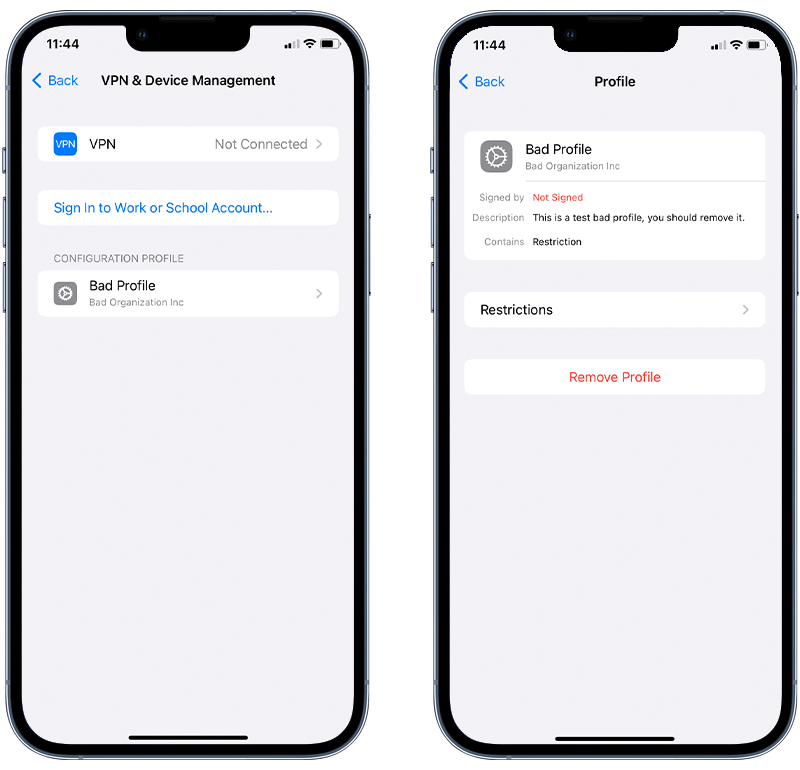
Fig 4. Checking for a configuration profile on iPhone.
💡 Note: If you don’t see this option in the menu, it means you don’t have any profiles installed on your device, and you are currently safe from this type of attack.
5. Check your location, microphone, and camera permissions
Sometimes an iPhone virus needs permission to use your iPhone’s location, microphone, or camera to get information from your device.
For example, they would need to use the microphone to listen to what you’re saying. One way to find out if there’s anything suspicious is by checking which apps can use these features on your phone.
💡 Pro Tip: Running a virus scan with Certo AntiSpy will also show you all of the apps (visible or hidden) that have access to your location, camera, or microphhttps://www.certosoftware.com/one.
If you want to check for yourself, here’s a step-by-step guide:
Location access
Follow these steps to check which apps have access to your location:
- Tap on the Settings app on your iPhone’s home screen.
- Scroll down and tap on Privacy & Security.
- In the Privacy & Security menu, find and tap on Location Services.
- You’ll see a list of apps that have permission to access your location.
- To change access for a specific app, tap on it and then choose your desired level of access.

Fig 5. Checking for apps with access to Location on iPhone.
💡 Key Point:
For each app, you can choose to allow certain levels of access:
➡️ Never: The app will never have access to your location.
➡️ Ask Next Time or When I Share: The app will ask for your permission to access your location the next time it needs it.
➡️ While Using the App: The app can access your location only when you are actively using it.
➡️ Always: The app can access your location anytime, even when you are not using it.
Microphone or camera access
To check which apps have access to your microphone or camera, follow these steps:
- Tap on the Settings app on your iPhone’s home screen.
- Scroll down and tap on Privacy & Security.
- In the Privacy & Security menu, find and tap on Microphone or Camera.
- You’ll see a list of apps that have permission to access your microphone or camera. Each app has a toggle switch next to it.
- To disable microphone or camera access for a specific app, toggle the switch next to the app’s name to the off position.
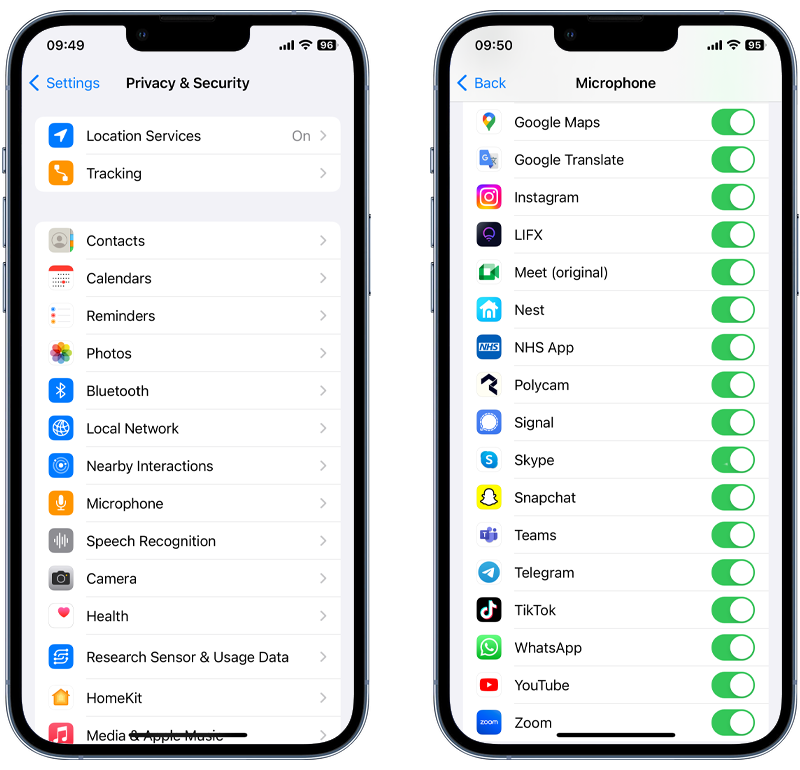
Fig 6. Checking for apps with access to Microphone on iPhone.
💡 Related: How To Turn Off Your Microphone On An iPhone
6. Scan your device for viruses
Using a good antivirus app is one of the most effective ways to uncover viruses and malware on an iPhone. Here is how to use Certo AntiSpy to scan your device:
✅ Download Certo AntiSpy: First, download and install Certo AntiSpy onto a computer. Why a computer? Traditional iPhone security apps can’t perform a full virus scan, however you can do this by connecting your device to a computer.
✅ Connect your iPhone: Launch Certo AntiSpy and connect your iPhone using a USB cable.
✅ Start the scan: Click the Scan button. The scan will take a few minutes to complete.
✅ Review the results: Once complete, Certo AntiSpy will display a report detailing any security issues, vulnerabilities, or viruses detected on your iPhone.
✅ Take action: If Certo AntiSpy finds any threats, follow the recommendations provided by the software to remove the virus or address any vulnerabilities. This could involve deleting suspicious apps, changing security settings, or following specific remediation steps provided by Certo.

Fig 7. Finding a virus on an iPhone with Certo AntiSpy.
How to Remove a Virus from an iPhone
If you suspect your iPhone has a malware infection, taking immediate action can help mitigate potential damage and secure your personal information.
Here’s a step-by-step guide on how to remove viruses, malware and other threats from your device:
1. Restart your iPhone
Sometimes, the simplest solutions can be the most effective. Just restarting your device is often all that is needed in order to remove certain active threats, for example a Jailbreak.
ℹ️ To restart your iPhone: Press and hold the side and volume buttons until the power off slider appears. Drag the slider to turn off your iPhone, then press and hold the side button again to turn it back on.
2. Update your iOS version
Apple regularly releases updates that patch security vulnerabilities in outdated software. Updating your iOS can remove existing threats and protect against future ones.
ℹ️ Go to Settings > General > Software Update. If an update is available, tap Download and Install.
3. Clear iPhone browsing data
Malware can lurk in your browsing history or cookies. Clearing your browsing data can help remove these threats.
ℹ️ Go to Settings > Safari > and tap Clear History and Website Data.
4. Remove suspicious apps
iPhone users should uninstall any apps they don’t recognize, especially if they didn’t download them from the App Store.
➡️ To check your apps: Go through your Home Screen and App Library. If you see an app that you don’t remember installing, investigate it further by searching online or drop us a message and our team will look into it.
➡️ To remove an iPhone app: If you see a strange app, press and hold the app icon until a menu appears, then select Remove App > Delete App.
5. Use an antivirus app
One of the easiest ways to remove a virus from your iPhone is to use a trusted antivirus app.
Once the app completes a virus scan on your device, you will be presented with the opportunity to securely delete any detected threats, restoring your device’s security. Many threats can be removed automatically; however, for more stubborn viruses, you will receive clear guidance on how to manually remove them.
6. Enable two-factor authentication
Two-factor authentication adds an extra layer of security to your Apple ID and iCloud services, helping protect against unauthorized access.
- Go to Settings > [your name] > Password & Security.
- Tap Turn On Two-Factor Authentication and follow the on-screen prompts.
7. Restore iOS from a previous backup
If you made a recent backup to a computer before the issue started, restoring your iPhone from this backup can revert any changes made before a malware attack.
Connect your iPhone to your computer and open Finder (on Mac) or iTunes (on PC).
Select your iPhone, choose Restore Backup, and pick the most relevant backup.
8. Factory reset iPhone
As a last resort, restoring to factory settings will erase all data and settings on your iPhone, removing any viruses or malware in the process. Be sure to back up important data first.
ℹ️ Go to Settings > General > Transfer or Reset iPhone. Tap Erase All Content and Settings and follow the prompts to reset your device and remove any malicious apps.
Final Thoughts
Today, ensuring the security of our devices has never been more crucial. This guide has shown you how to scan your iPhone or iPad to detect viruses.
We’ve also given you some key tips on removing threats from your device.
Remember, digital security is a continuous journey. Staying informed, vigilant, and proactive are key to ensuring your device remains safe and secure.
To keep your iPhone secure, incorporate regular checks and updates, carefully select apps, and browse the web cautiously.
If you are looking for an additional layer of protection for your iPhone, consider using a specialist security tool like Certo AntiSpy.